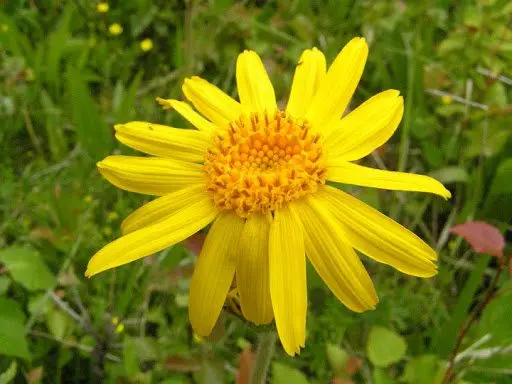Contents
Mountain Arnica is a herbaceous plant with yellow flowers resembling daisies. On the post-Soviet territory, it is found in the Carpathian region, in the Baltic states and in the west of Belarus, but its main distribution area is the mountainous regions of Western Europe. In folk medicine, the plant has been used since antiquity as a remedy for bleeding, inflammation and muscle pain. Arnica tincture helps with neuralgia, diseases of the musculoskeletal system, relieves swelling and bruising, stops bleeding.
Healing properties of arnica
The description of the plant is found in the writings of the ancient Greek botanist and military doctor Pedanius Dioscorides. In ancient times, wounded warriors were treated with arnica, as it accelerated healing. Arnica montana is included in the USSR Pharmacopoeia as an antispasmodic, hemostatic and sedative. Soviet botanists repeatedly tried to cultivate the plant to collect medicinal raw materials, but these attempts were unsuccessful.
For medical purposes, preparations from arnica inflorescences are mainly used, since there are much less useful substances in the leaves and roots. One of the most effective components of the plant is helenalin, which effectively fights tumors and inflammation due to its ability to stimulate the production of the necessary enzymes in the body. At the same time, the substance is extremely toxic, so the product cannot be used to treat open wounds.
In addition to gelenalin, arnica contains:
- fatty and organic acids;
- sequiterpene – neutralizes harmful bacteria;
- betaine – compensates for the lack of vitamin B12;
- cynarin – lowers cholesterol;
- gelenin – stimulates gastrointestinal motility and stimulates the production of gastric juice;
- arnifoline – acts as a choleretic agent.
Homeopathic remedies with arnica are available in specialized stores and pharmacies, and gels and ointments are in high demand, which relieve pain from severe bruises and remove bruises. In alternative medicine, arnica tincture is prescribed orally for uterine and nosebleeds, for the treatment of angina pectoris, vasodilation and cleansing of their walls from cholesterol plaques.

The external action of arnica has been well studied. In 2015, the journal Complementary & Alternative Medicine published the results of a series of studies demonstrating the high potential of A. Montana for use in the treatment of muscle pain and sports injuries. A year later, an article was published in the American Journal of Therapeutics reviewing experiments that established the effectiveness of the plant in the treatment of postoperative pain and swelling. However, arnica should be taken internally with caution and only on the recommendation of a doctor, as scientific data on the side effects of the drug are not yet enough.
Preparation of arnica tincture
The plant is harvested in late June – early July, when flowering is in full swing. Natural reserves of arnica are very small, so its collection is fraught with great difficulties. The flowers are cut at the very base and then dried in the open air for 10 days. Raw materials cannot be turned over, as the petals instantly crumble. Procurers sell flower baskets in online stores. When buying, you need to pay attention to the year of collection of medicinal raw materials, since its shelf life does not exceed two years.

Arnica tincture on vodka is stored much longer, while alcohol dissolves useful components well and retains their effectiveness. Four tablespoons of flowers (about 50 g) must be placed in a jar, pour 0,5 liters of vodka and insist for 8-10 days in a place protected from light. The finished tincture must be filtered, poured into a dark glass container and stored at room temperature.
Application of arnica tincture
Tincture is taken orally 30-40 drops twice a day before meals for 14 days with frequent nosebleeds, gynecological problems, high cholesterol. Compresses with arnica relieve pain in the joints and muscles, lotions should be done daily for a week, but at the same time, carefully monitor the condition of the skin. The herbal remedy effectively fights bleeding gums, in this case, applications are made twice a day.
Contraindications and precautions
Arnica is dangerous even in a highly diluted form, so during treatment you need to carefully monitor your condition.
Side effects when taken orally:
- nausea, vomiting, diarrhea;
- irritation of the oral mucosa;
- tachycardia;
- increased blood pressure.
If at least one of the symptoms appears, treatment should be stopped immediately. Arnica slows down blood clotting, so it should not be taken before surgery to avoid bleeding. The drug may enhance the effect of blood thinners (warfarin, Plavix, heparin). Tincture is contraindicated during pregnancy and during breastfeeding.
Attention! Self-medication can be dangerous, consult your doctor.









